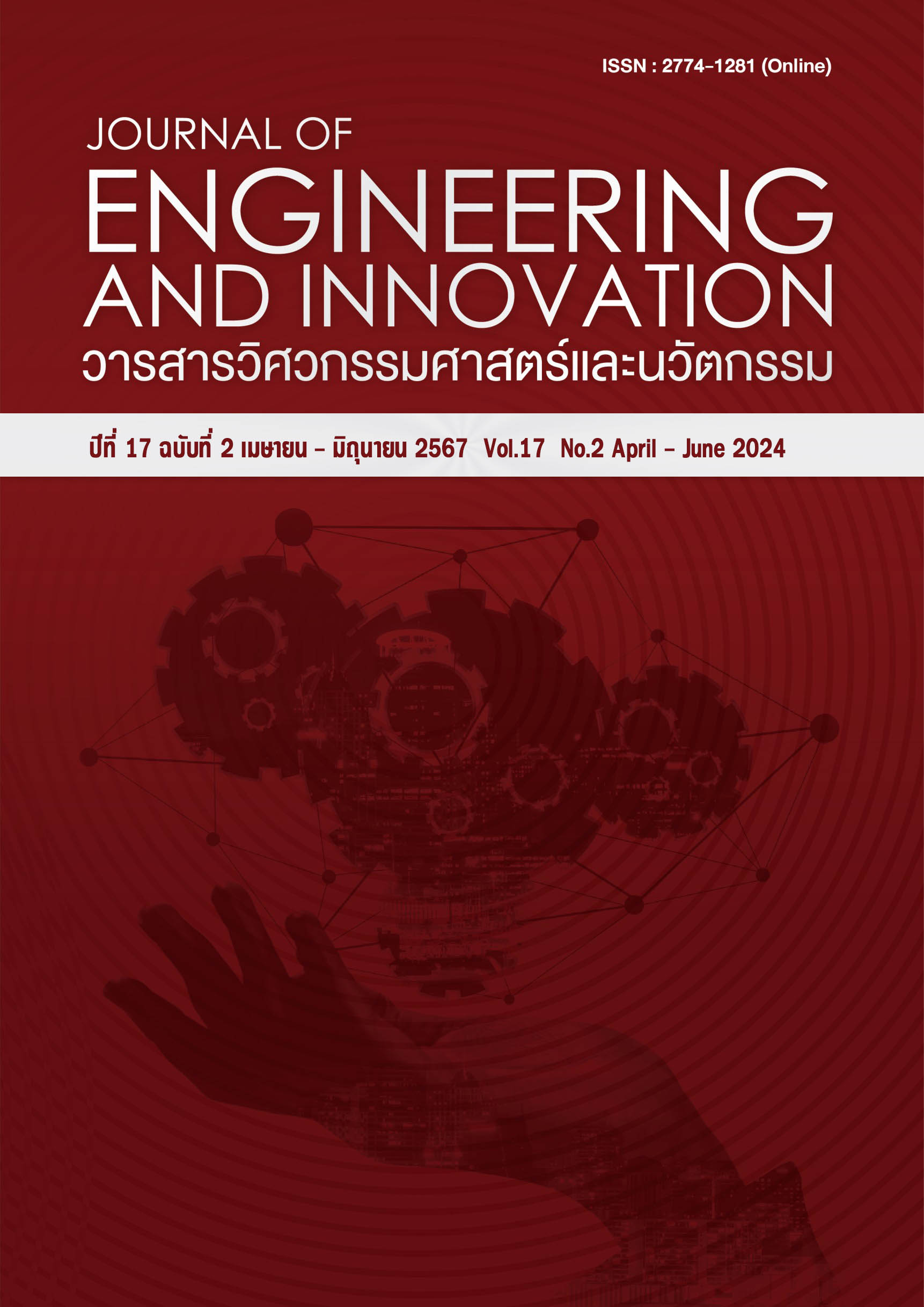การตามรอยจุดกำลังสูงสุดด้วยฟัซซีลอจิกร่วมกับวีธีการรบกวนและสังเกตของระบบเซลล์แสงอาทิตย์แบบอิสระ
Main Article Content
บทคัดย่อ
บทความนี้นำเสนอการตามรอยจุดกำลังไฟฟ้าสูงสุดสำหรับระบบเซลล์แสงอาทิตย์แบบอิสระ ระบบที่พิจารณาประกอบไปด้วยเซลล์แสงอาทิตย์ที่เชื่อมต่อกับวงจรแปลงผันแบบบัคก์และใช้แบตเตอรี่เป็นแหล่งเก็บพลังงาน ระบบการตามรอยจุดกำลังไฟฟ้าสูงสุดโดยทั่วไปจะใช้วิธีการรบกวนและสังเกตเนื่องจากมีการควบคุมที่ง่าย ประสิทธิภาพของวิธีรบกวนและสังเกตขึ้นอยู่กับขนาดของสัญญาณควบคุม โดยใช้อัตราการเปลี่ยนแปลงของค่าวัฏจักรหน้าที่ () เป็นสัญญาณควบคุมฟัซซีลอจิกสามารถนำมาใช้งานกับระบบที่ไม่เป็นเชิงเส้นได้ซึ่งทำให้มีการนำไปใช้ได้กับระบบหลายระบบ ในบทความนี้อาศัยฟัซซีลอจิกกำหนดค่า ที่เหมาะสมเพื่อเพิ่มประสิทธิภาพในการควบคุม วิธีการที่นำเสนอจะยืนยันประสิทธิภาพโดยใช้ Simulink ในโปรแกรม MATLAB การทดสอบในห้องปฏิบัติการและชุดต้นแบบขนาด 2.4 kW ที่นำไปใช้กับโรงเรือนควบคุมระบบจ่ายน้ำ ณ ฟาร์มมหาวิทยาลัยเทคโนโลยีสุรนารี ผลการจำลองและผลการทดสอบแสดงให้เห็นว่าวิธีที่นำเสนอสามารถลู่เข้าสู่จุดกำลังสูงสุดได้เร็วกว่าและลดการแกว่งของกำลังไฟฟ้าได้ดีกว่าเมื่อเทียบกับวิธีรบกวนและสังเกต
Article Details
เอกสารอ้างอิง
Trishan Esram, Patrick L. Chapman “Comparison of Photovolaic Array Maximum Power Point Tracking Techniqued” in IEEE Trans., Energy Conversion., Vol.22, No2, pp 439-449, July 2007
D. K. Sharma, G.Purohit, “Advanced Perturbation and Observation (P&O) based Maximum Power Point Tracking (MPPT) of a Solar Photo-Voltaic System” in IEEE, 2012
Ratil H Ashique, Zainal Salam, Jubaer Ahmed, “An Adaptive P&O MPPT Using a Sectionalized Piece-wise Linear P-V Curve” in IEEE, 2015
Maissa Farhat, Oscar Barambones, Lassaad Sbita “A Real-Time Implementation of MPPT-Based on P&O Method” in IEEE, 2016
HAYDER Wafa, ABID Aicha, BEN HAMED Mouna, “Steps of duty cycle effects in P&O MPPT algorithm for PV system” in IEEE, 2017
Murari Lal Azad, Soumya Das, Pradip Kumar Sadhu, Biplab Satpati, Anagh Gupta, P. Arvind “P&O algorithm based MPPT technique for solar PV System under different weather conditions” in ICCPCT, 2017
S. Uma Ramani, Sathish Kumar Kollimalla, B. Arundhati “Comparitive Study of P&O and Incremental Conductance method for PV System” in ICCPCT, 2017
Aicha Djalab, Ali Teta, Mohamed Mounir Rezaoui, Mohamed Boudiaf, “Analysis of MPPT Methods: P & O, INC and Fuzzy Logic (CLF) for a PV System” in CEIT, 25-27 October 2018, Istanbul, Turkey
Kriti Jain, Prof. Manju Gupta, Dr. Aashish Kumar Bohre, “Implementation and Comparative Analysis of P&O and INC MPPT Method for PV System” in IEEE, 2018
Mohammed Zerouali, Salaheddine Zouirech, Abdelghani El Ougli, Belkassem Tidhaf, Hafida Zrouri, “Improvement of Conventional MPPT
Techniques P&O and INC by Integration of
Fuzzy Logic” in IEEE, 2019
Dikshita Nath, Tilok Boruah, “P&O and Fuzzy based MPPT for PV System” in IEEE, 2020
Dr. szemes, Peter Tamas, Masoud Melhem, “Analyzing and modeling PV with "P&O" MPPT Algorithm by MATLAB/SIMULINK” in IEEE, 2020
Savita Baraskar, Sachin Kunmar Jain, and Prabim K.Padhy “Fuzzy logic assisted P&O based improved MPPT for photovoltaic systems,” in Proc. ICETEESES – 16, March 2016
Bibhu Prasad Ganthia, Rosalin Pradhan, Sibani Das, Sibani Ganthia, “Analytical Study of MPPT based PV System using Fuzzy Logic Controller” in ICECDS, 2017
Dilovan Haji, Naci Genc, “Fuzzy and P&O Based MPPT Controllers under Different Conditions” in ICRERA, Paris, FRANCE, Oct. 14-17, 2018
Jaldeep Kumar, Jaldeep Kumar, Prakash Bahrani, “Fuzzy and P&O MPPT Techniques for Stabilized
the Efficiency of Solar PV System” in GUCON, Greater Noida, UP, India. Sep 28-29, 2018

